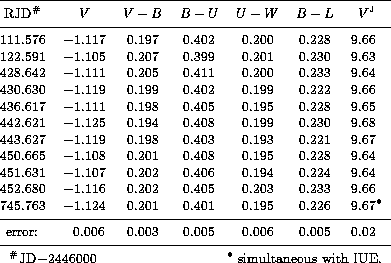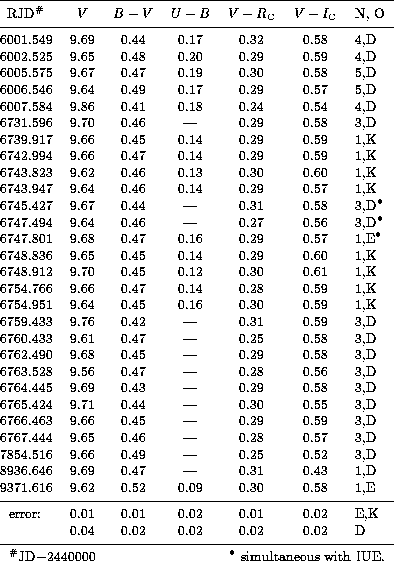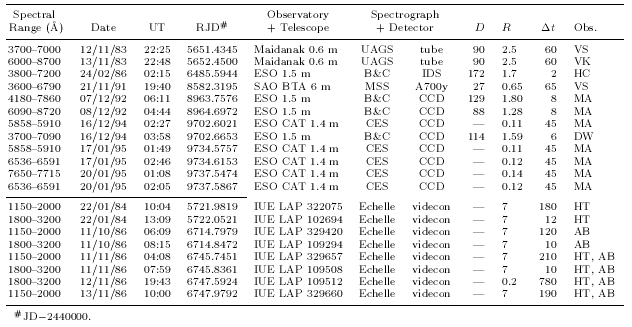The variable character of BN Ori was detected by Cannon (1919) and since then
the star has been monitored extensively both visually and photographically.
Tsesevich made nearly 4000 ![]() estimates of BN Ori from sky patrol
photographic plate collections of the Harvard, Odessa, Sonneberg and Dushanbe
observatories and constructed a light curve of
estimates of BN Ori from sky patrol
photographic plate collections of the Harvard, Odessa, Sonneberg and Dushanbe
observatories and constructed a light curve of ![]() over the period 1898- 1964
(Dragomiretskaya 1965; Tsesevich & Dragomiretskaya 1973).
over the period 1898- 1964
(Dragomiretskaya 1965; Tsesevich & Dragomiretskaya 1973).
![]()
Figure 1:
Lightcurve of ![]() for BN Ori over the period 1898- 1964, constructed by
Tsesevich & Dragomiretskaya (1973), and extended up to 1995
for BN Ori over the period 1898- 1964, constructed by
Tsesevich & Dragomiretskaya (1973), and extended up to 1995

Table 2:
Photometric Data of BN Ori on the Walraven (WULBV) system

Table 3:
Photometric Data of BN Ori on the Johnson/Cousins ![]() system.
The last column (N, O) gives the number of observations per night and the
observatory: DASA(D), ESO(E) or Kitt Peak(K)
system.
The last column (N, O) gives the number of observations per night and the
observatory: DASA(D), ESO(E) or Kitt Peak(K)
This light curve of BN Ori shows quiet periods with maximum brightness
![]()
![]() 97, during which the brightness frequently decreases by at most
05, separated by episodes of roughly 12.5 years, during which the mean
brightness dropped with 1
97, during which the brightness frequently decreases by at most
05, separated by episodes of roughly 12.5 years, during which the mean
brightness dropped with 1![]() or 2
or 2![]() over 100- 200 days or with
3
over 100- 200 days or with
3![]() over 20- 50 days. Superposed on this long-term variability are
rapid fluctuations with amplitude of 15 during about 10 days.
It was already noted by Beyer (1937) and confirmed by Hoffmeister (1949) and
Payne-Gaposhkina (1952) that the behaviour of BN Ori is reminiscent of that of
the RW Aur variables T Ori and XY Per and we can extend the similarity now to
other Herbig Ae stars with Algol-type minima such as BF Ori, UX Ori, WW Vul
and HR 5999.
In a discussion of the photometric variability of BN Ori, Dragomiretskaya (1965)
concluded that the large amplitude-variations cannot be due to temperature
differences on the stellar surface, since a dimming
over 20- 50 days. Superposed on this long-term variability are
rapid fluctuations with amplitude of 15 during about 10 days.
It was already noted by Beyer (1937) and confirmed by Hoffmeister (1949) and
Payne-Gaposhkina (1952) that the behaviour of BN Ori is reminiscent of that of
the RW Aur variables T Ori and XY Per and we can extend the similarity now to
other Herbig Ae stars with Algol-type minima such as BF Ori, UX Ori, WW Vul
and HR 5999.
In a discussion of the photometric variability of BN Ori, Dragomiretskaya (1965)
concluded that the large amplitude-variations cannot be due to temperature
differences on the stellar surface, since a dimming

Table 4:
NIR photometric data of BN Ori
by 15 would already require a full coverage by cool spots of the stellar surface. Dragomiretskaya also used the visual photometry by Esch (1925), Beyer (1937) and Martinov (1951), to derive the colour indices for a number of dates and the resulting colour-magnitude diagram shows that the strong variations of BN Ori follow a reddening-line similar to those followed by many Herbig Ae stars. Such a type of variation is usually ascribed to obscuration by variable amounts of circumstellar dust (Wenzel 1968; Wenzel et al. 1971). For BN Ori the slope of the reddening-line was about 3, which is close to that of interstellar dust. Tsesevich & Lange observed that BN Ori showed Algol-like variations with a period of 27 days (Martinov 1951). From an analysis of quasi-periodic features during high-activity episodes in the light curve of BN Ori, Ishchenko (1982) detected a quasi-cyclic 18- 22 day periodicity superimposed on a stochastical behaviour and attributed this periodicity to the rotation of obscuring circumstellar dust clouds.
Figure 1 (click here) shows that the large-scale structure of the light curve
changed around 1940: the amplitude of the strong variations decreased and the
brightness maximium increased to ![]()
![]() 92 in Dec'46. Since then the
variations were gradually quenched from an amplitude of 04 to about 01
in 1966, while the maximum of the brightness-variations slowly decreased
to
92 in Dec'46. Since then the
variations were gradually quenched from an amplitude of 04 to about 01
in 1966, while the maximum of the brightness-variations slowly decreased
to ![]()
![]() 101. In Sect. 6 (click here)
we shall compare this behaviour with those of classical FUORs.
After 1965 all observations have been made photoelectrically. Between 1965 and
1975 Zajtseva (1968, 1970), Kolotilov & Zajtseva (1976) and
Kolotilov et al.
(1977) have made several observations of BN Ori on the UBV and
JHKL photometric systems, but they did not detect a pronounced variation.
101. In Sect. 6 (click here)
we shall compare this behaviour with those of classical FUORs.
After 1965 all observations have been made photoelectrically. Between 1965 and
1975 Zajtseva (1968, 1970), Kolotilov & Zajtseva (1976) and
Kolotilov et al.
(1977) have made several observations of BN Ori on the UBV and
JHKL photometric systems, but they did not detect a pronounced variation.
The star has been observed regularly by various observers on several photometric systems (see Table 1 (click here)).

Figure 2:
Observed (squares) and extinction-corrected (circles) SED of BN Ori based on the
data of Feb'86.
The L-band observation of Cohen (1973) is indicated by the "upper" triangle
(with error-bar).
The L-band observation from Table 4 (click here) is indicated by the
"lower" triangle (with upperlimit).
The solid line is the Kurucz model of ![]() = 7150K,
= 7150K, ![]() = 3.8 and solar
abundance, normalised to the extinction-corrected V-band flux of BN Ori.
The dotted lines are the observed- and extinction-corrected UV-fluxes
= 3.8 and solar
abundance, normalised to the extinction-corrected V-band flux of BN Ori.
The dotted lines are the observed- and extinction-corrected UV-fluxes
After transformation of the data on the various systems to the
Johnson magnitude ![]() and colour
and colour ![]() we can hardly find any
change in brightness and colour over these years. The average values are:
we can hardly find any
change in brightness and colour over these years. The average values are:
![]() = 965
= 965 ![]() 003 and
003 and ![]() = 047
= 047 ![]() 002.
Only on one occasion (Oct.29- Nov.2, 1991), the star seemed to dim by
05 (Kovalchuk 1991). Because there are no data available for the
34 nights preceding Oct.29 and for the 12 nights following Nov.2, we can only
state that the variation was limited to at most 51 nights. The variation is
along the reddening-line with slope 3, so that this event could have been due
to infalling circumstellar dust which evaporated in the neighbourhood of the
star.
002.
Only on one occasion (Oct.29- Nov.2, 1991), the star seemed to dim by
05 (Kovalchuk 1991). Because there are no data available for the
34 nights preceding Oct.29 and for the 12 nights following Nov.2, we can only
state that the variation was limited to at most 51 nights. The variation is
along the reddening-line with slope 3, so that this event could have been due
to infalling circumstellar dust which evaporated in the neighbourhood of the
star.
Since 1976 we have obtained only two observations in the NIR
(Table 4 (click here)), and in Fig. 2 (click here) we give a SED of BN Ori
based on these data of Feb'86. After transformation of the magnitudes to
fluxes and correction of these fluxes
for foreground extinction with the law of Savage & Mathis (1979) and
E(B-V) = 007 (Sect. 4.3 (click here)),
the corrected SED could be fitted with a Kurucz (1991) model
for ![]() = 7150K
and
= 7150K
and ![]() , corresponding to a spectral type of F0III - IV
(Sect. 5 (click here))
and an E(B-V) = 017.
From Fig. 2 (click here) we note that we get a good agreement in the visual and NIR
wavelength ranges, but that there remains an excess in the UV.
This excess will be explained (Sect. 5 (click here))
in terms of the contribution from a (hot) boundary layer between the star and
accretion-disc.
If we compare our NIR data of 1986 with those obtained before 1977 (Glass & Penston 1974;
Kolotilov et al. 1977) we note no difference in the H and K magnitudes.
However, our J-band flux is somewhat larger than that of Kolotilov et al.
and our L-band flux is significantly smaller than the one
Cohen (1973;
, corresponding to a spectral type of F0III - IV
(Sect. 5 (click here))
and an E(B-V) = 017.
From Fig. 2 (click here) we note that we get a good agreement in the visual and NIR
wavelength ranges, but that there remains an excess in the UV.
This excess will be explained (Sect. 5 (click here))
in terms of the contribution from a (hot) boundary layer between the star and
accretion-disc.
If we compare our NIR data of 1986 with those obtained before 1977 (Glass & Penston 1974;
Kolotilov et al. 1977) we note no difference in the H and K magnitudes.
However, our J-band flux is somewhat larger than that of Kolotilov et al.
and our L-band flux is significantly smaller than the one
Cohen (1973; ![]() 76)
measured in 1971.
The earlier attempts to match the SED (Kolotilov & Zajtseva 1976;
Brown et al. 1986)
were based on this higher L-band flux.
No IRAS point-source was detected at the position of BN Ori, probably because the far-IR
fluxes of the star are not higher than the background.
76)
measured in 1971.
The earlier attempts to match the SED (Kolotilov & Zajtseva 1976;
Brown et al. 1986)
were based on this higher L-band flux.
No IRAS point-source was detected at the position of BN Ori, probably because the far-IR
fluxes of the star are not higher than the background.
From the Walraven photometry
(which has two passbands in the UV: W at 3236Å and U at 3623Å),
we can get a measure of the magnitude of the Balmer discontinuity (![]() ).
The mean of the 9 observations of Dec'85- Jan'86 gives
).
The mean of the 9 observations of Dec'85- Jan'86 gives ![]() .
This is a deficiency of 048 with respect to the prediction of the
Kurucz (1991) model for
.
This is a deficiency of 048 with respect to the prediction of the
Kurucz (1991) model for ![]() = 7200K and
= 7200K and ![]() which we take
for the classification F0III (Sect. 5 (click here)).
If this is due to the contribution of recombination of H
which we take
for the classification F0III (Sect. 5 (click here)).
If this is due to the contribution of recombination of H![]() free-bound
transitions near the star, we can derive (Garrison 1978) that for a
temperature of 10
free-bound
transitions near the star, we can derive (Garrison 1978) that for a
temperature of 10![]() K in this region the emission measure is
1.86
K in this region the emission measure is
1.86 ![]() cm
cm![]() .
If we assume that this ionosphere is in hydrostatic equilibrium with a
scale-height of 4
.
If we assume that this ionosphere is in hydrostatic equilibrium with a
scale-height of 4![]() we find within 2
we find within 2![]() an electron density
an electron density
![]() = 3.34
= 3.34 ![]() cm
cm![]() .
.
For HR 5999 (A5- 7III) we used the Walraven photometry to derive a
![]() equal to 123 which results in a deficiency of 020 when
compared to a Kurucz (1991) model with
equal to 123 which results in a deficiency of 020 when
compared to a Kurucz (1991) model with ![]() = 8000K. This gives
an emission measure of 6.0
= 8000K. This gives
an emission measure of 6.0 ![]() cm
cm![]() , which corresponds to
, which corresponds to
![]() = 5.6
= 5.6 ![]() cm
cm![]() close to the star, so that
close to the star, so that ![]() is 2.8 times the value found for BN Ori.
is 2.8 times the value found for BN Ori.

Table 5:
Log of spectroscopic
observations of BN Ori. Columns 8 to 10 denote the
dispersion ![]() (
(![]() ) the resolution
) the resolution ![]() (
(![]() ) and the
exposure time
) and the
exposure time ![]() (min).
The IUE imagenumbers are given in Col. 5 and the first digit denotes the used
camera (1 = LWP, 3 = SWP) and LAP means large aperture.
Observers: AB - A. Brown, DW - D. de Winter, HC - H. Cuypers, HT - H.R.E. Tjin A Djie,
MA - M.E. van den Ancker, VK - V. Kotyshev, VS - V.S. Shevchenko
(min).
The IUE imagenumbers are given in Col. 5 and the first digit denotes the used
camera (1 = LWP, 3 = SWP) and LAP means large aperture.
Observers: AB - A. Brown, DW - D. de Winter, HC - H. Cuypers, HT - H.R.E. Tjin A Djie,
MA - M.E. van den Ancker, VK - V. Kotyshev, VS - V.S. Shevchenko